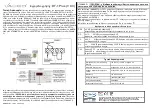
February 02, 2024
DXM1200-X2 Controller Instruction Manual
© Banner Engineering Corp. All rights reserved.
31
•
•
•
•
•
Disable Ethernet Port
Set to ON to power down the Ethernet interface. Disabling the
unused Ethernet port reduces power consumption.
The factory default position is OFF.
Disable LCD Display
Set to ON to disable the LCD. This DIP switch should be ON
when the LCD board is not connected.
The factory default position is OFF.
Ethernet
Before applying power to the DXM Controller, verify the Ethernet cable is connected.
The number of times the processor attempts to connect to the Ethernet network is configured in the DXM Configuration
Software (Settings
›
Network Ethernet Connection Acquisition). The default setting is two retries one minute after the device
boots up and another retry two minutes later.
The Ethernet connection supports the DXM Configuration Software, Modbus/TCP, and EtherNet/IP. ScriptBasic also has
access to Ethernet for custom programming. Use the software or LCD menu system to configure the characteristics of the
Ethernet connection, including the IP address. Any parameters not changeable from the menu system are configurable from
the configuration software.
Ethernet parameter changes entered through the LCD menu override the XML configuration parameters. To return to using
the network settings in the XML configuration file, remove the Ethernet parameters defined by the LCD menu using the
System Config
›
Ethernet
›
Reset menu.
USB
A micro USB port is available inside the DXM Controller.
The micro USB port can be used to configure the DXM, but a micro USB cable is not provided with the device.
Internal Local Registers (ID 199) for the DXM700, DXM1000,
and DXM1200
The main storage elements for the DXM Controller are its local registers, which can store 4-byte values that result from
register mapping, action rules, or ScriptBasic commands.
Local registers updated from Modbus transactions are restricted to a 16-bit data value to follow standard Modbus holding
register definition.
The local registers defined in action rules must all be within the same register group. For example, an action rule cannot have
inputs from an integer group with the result register defined as a floating point register. To move between integers and floats,
use the Register Copy Rule.
Local registers 1–850 and 5001–7000 are 32-bit integer registers
Local registers 851–900 and 7001–8000 are non-volatile 32-bit integer registers
Local registers 901-1000 are reserved for internal use
Local registers 1001–5000 are floating point format numbers, each address stores half of a floating point number; for
example, registers 1001 and 1002 store the first full 32-bit floating point number
Local registers 10000 and higher are read-only virtual registers; virtual registers collect various system-level data
Modbus registers for internal local registers (Modbus ID 199)
Local Registers
Type
Description
1–845
32-bit integer
Local data registers
846–849
32-bit integer
Reset, Constant, Timer
851–900
32-bit non-volatile integer
Data flash, non-volatile
901–1000
Reserved for internal use
1001–5000
Floating point
Floating point registers, local data registers
5001–7000
32-bit integer
Local data registers
7001–8000
32-bit non-volatile integer
Data flash, non-volatile
> 10000
Read-only virtual registers, system-level data
Summary of Contents for DXM1200-X2
Page 4: ...4 Warnings 81 Banner Engineering Corp Limited Warranty 82 Document Information 82...
Page 20: ...20...
Page 28: ...28...
Page 36: ...36...
Page 44: ...44...
Page 62: ...62...
Page 70: ...70...
Page 72: ...72...
Page 83: ...LinkedIn Twitter Facebook 2024 All rights reserved www bannerengineering com...
















































